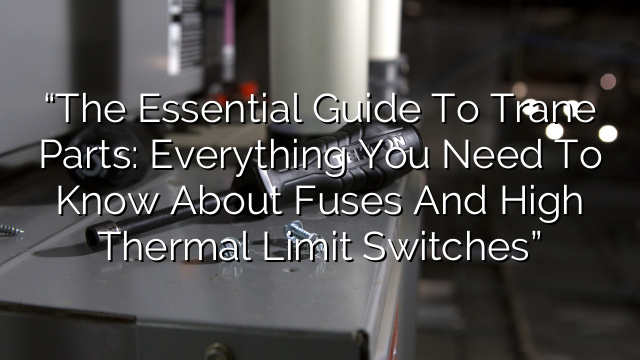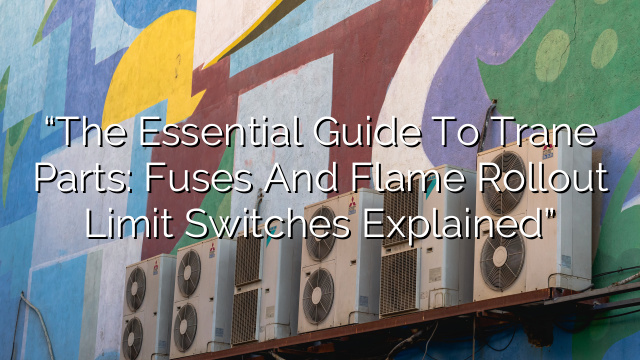When it comes to Trane heating and cooling systems, having the right parts is crucial for maintaining optimal performance. In this comprehensive guide, we will take a closer look at two important Trane parts – fuses and high thermal limit switches. We will explore what they are, their functions, and how to troubleshoot and replace them if needed. So, let’s dive in!
Fuses
What are fuses?
A fuse is a safety device that protects electrical circuits from excessive current flow. It is a small, thin wire that melts when too much current passes through it, thus interrupting the electrical circuit. Fuses are commonly used in Trane heating and cooling systems to protect components such as motors and transformers from damage due to electrical overload.
How do fuses work?
When the current flowing through a circuit exceeds a predetermined limit, the fuse wire heats up and eventually melts, breaking the circuit. This prevents further current flow and protects the components from damage. Fuses are designed to be the weakest point in the circuit, sacrificing themselves to protect the more expensive components.
How to troubleshoot a blown fuse?
If your Trane system is not functioning as it should, a blown fuse could be the culprit. Here’s how you can troubleshoot a blown fuse:
- Check for power: Before checking the fuse, ensure that there is power to your system. Verify that circuit breakers are not tripped and that power switches are turned on.
- Locate the fuse: Fuses are typically located in the service panel of your Trane system. Consult the owner’s manual or the manufacturer’s website to find the exact location.
- Inspect the fuse: Visually inspect the fuse to see if the wire inside is intact or if it is blown. A blown fuse will have a broken or melted wire.
- Replace the fuse: If the fuse is blown, carefully remove it and replace it with a new one of the exact same rating. Be sure to use the correct type and size of fuse.
- Test the system: After replacing the fuse, turn on your Trane system and check if it is functioning properly. If not, there may be another underlying issue that requires professional attention.
High Thermal Limit Switches
What is a high thermal limit switch?
A high thermal limit switch is a safety device that protects Trane heating and cooling systems from overheating. It is usually located near the heat exchanger or combustion chamber and monitors the temperature of the system. If the temperature exceeds a certain limit, the high thermal limit switch shuts off the system to prevent damage.
How does a high thermal limit switch work?
A high thermal limit switch consists of a bimetallic strip that bends when heated. When the temperature of the system rises above the limit, the bimetallic strip bends, causing the switch to open and interrupt the circuit. This stops the flow of electricity to the system, preventing further heating and potential damage.
How to troubleshoot a faulty high thermal limit switch?
If your Trane system is not heating properly or is constantly shutting off, a faulty high thermal limit switch may be the problem. Here are some steps to troubleshoot and potentially replace a faulty high thermal limit switch:
- Check for power: Verify that there is power to your system before troubleshooting the high thermal limit switch. Ensure that circuit breakers are not tripped and that power switches are turned on.
- Locate the high thermal limit switch: The high thermal limit switch is typically located near the heat exchanger or combustion chamber. Refer to the owner’s manual or the manufacturer’s website for the precise location.
- Reset the switch: Some high thermal limit switches have a reset button. Press the reset button to see if it resolves the issue. However, if the switch keeps tripping repeatedly, it is an indication of a deeper problem that requires professional attention.
- Test the switch: Use a multimeter to test the continuity of the high thermal limit switch. Follow the instructions provided with the multimeter to properly perform the test. If there is no continuity, the switch is likely faulty and needs to be replaced.
- Replace the switch: If the high thermal limit switch is faulty, carefully remove it and replace it with a new one of the same specifications. Ensure that the replacement switch is compatible with your Trane system.
- Test the system: After replacing the high thermal limit switch, turn on your Trane system and observe if it is functioning properly. If the problem persists, it is advisable to seek professional assistance.
FAQs
Q: Can I replace a fuse or high thermal limit switch myself?
A: Yes, you can replace a fuse or high thermal limit switch yourself if you have the necessary knowledge and skills. However, if you are unsure or uncomfortable with electrical work, it is always recommended to seek professional assistance to ensure safety and proper installation.
Q: Where can I purchase Trane fuses and high thermal limit switches?
A: Trane parts, including fuses and high thermal limit switches, can be purchased from authorized Trane dealers or authorized online retailers. Ensure that you are purchasing genuine Trane parts to maintain the quality and performance of your system.
Q: How often should fuses and high thermal limit switches be replaced?
A: Fuses and high thermal limit switches do not typically need regular replacement unless they are faulty or have been exposed to extreme conditions. It is advisable to inspect them during regular system maintenance or if you experience any issues with your Trane system.
Q: Are there any precautions to take when working with electrical components?
A: Yes, when working with electrical components, always ensure that the power is turned off before starting any work. Use appropriate safety equipment, such as insulated gloves and goggles, and follow proper electrical guidelines. If you are unsure or uncomfortable with electrical work, consult a professional.
Q: Can a blown fuse or faulty high thermal limit switch cause damage to other parts of the Trane system?
A: Yes, a blown fuse or faulty high thermal limit switch can cause damage to other components of the Trane system if left unaddressed. This is why it is essential to promptly replace them to prevent further damage and ensure the proper functioning of the system.
In conclusion, understanding Trane parts such as fuses and high thermal limit switches is crucial for maintaining the performance and safety of your heating and cooling system. If you encounter any issues, it is recommended to consult the owner’s manual or seek professional assistance for proper troubleshooting and replacement. Remember, safety should always be the top priority when working with electrical components.










